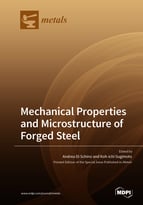Low and Medium Carbon Advanced High-Strength Forging Steels for Automotive Applications
Round 1
Reviewer 1 Report
This state-of-the-art is interesting and may have a lot of potential readers in this journal. The reviewer's expectation would be to have more specific data concerning the steels described for possible designing usage. Specifically, it would be interesting what is temperature effect on mechanical characteristics of these steels - to be further possibly applicable in engineering structures subjected to fire danger. Physical data necessary for a computer simulation have been included in: M. Kamiński, M. Strąkowski, On sequentially coupled thermo-elastic stochastic finite element analysis of the steel skeletal towers exposed to fire, Eur. J. Mech. A/Solids, 62, 80-93, 2017.
Author Response
Thanks for your reviewing and comments. It is expected that the present advanced high-strength forging steels are applied to the automotive powertrain and chassis parts. As you expect, however, the other engineering structures except automobile are excepted. Unfortunately, the application to engineering structure subjected to fire danger may be impossible because retained austenite in the AFSs break down into ferrite and carbide at temperatures higher than 400 °C.
According to your suggestion, the following sentence was added at the end of Summary.
Finally, authors want to emphasize that the AFSs may be applied to not only automotive powertrain and chassis parts but also the other engineering structures such as construction machinery, airplane, marine machinery, etc. The applications will increase many fracture strengths and resultantly bring about a great increase in reliability.
Others: Reference numbers of 79, 80 and 81 were changed into 80, 81 and 79.
Author Response File: ![]() Author Response.pdf
Author Response.pdf
Reviewer 2 Report
A nice and comprehensive review of high-strength forging steels with an explanation of the main microstructural features of individual groups of steels. The manuscript is written in good English and is readable.
The only drawback of the manuscript is in rather a general description of applications of named types of steels. Could the authors add more examples of the tangible practical applications of individual types of steels described in the article? For example, what particular part will be produced by forging and QP process described in Fig. 9. The authors could also state what particular parts could be produced with advantage by forging of various types of advanced high strength steels, even if they are not yet used commercially.
Author Response
Thanks for your reviewing and comments.
Authors expect that the AFSs subjected to forging and Q&P process in Fig. 9 are applied to many automotive powertrain and chassis parts such as bolts, screws, gears, connecting rod, crank shaft, driveshaft differential, constant velocity joint, wheel carrier, suspension, etc., in the same way as CFSs. This is stated in L214 to L217. As the other applications, authors expect the applications to construction machinery, airplane, marine machinery, etc. which are not used commercially. According to reviewer’s comment, the following sentence was added at the end of Summary.
Finally, authors want to emphasize that the AFSs may be applied to not only automotive powertrain and chassis parts but also the other engineering structures such as construction machinery, airplane, marine machinery, etc. The applications will increase many fracture strengths and resultantly bring about a great increase in reliability.
Others: Reference numbers of 79, 80 and 81 were changed into 80, 81 and 79.
Author Response File: ![]() Author Response.pdf
Author Response.pdf




